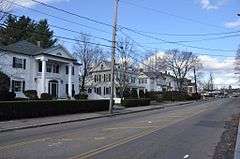Newtonville Historic District
|
Newtonville Historic District | |
|
Walnut Street in Newtonville | |
| Location | Newton, Massachusetts |
|---|---|
| Area |
40.5 acres (16.4 ha) (original) 7.8 acres (3.2 ha) (1990 increase) |
| Architect | Brown,Samuel J.; Et al. |
| Architectural style | Colonial Revival, Greek Revival, Late Victorian |
| MPS | Newton MRA |
| NRHP Reference # |
[1] (original) 90000014 (increase) |
| Significant dates | |
| Added to NRHP | September 04, 1986 |
| Boundary increase | February 6, 1990 |
The Newtonville Historic District is a historic district in the village of Newtonville, in Newton, Massachusetts. The district encompasses the southern portion of the village's business district (south of the railroad tracks), as well as surrounding residential areas. It was listed on the National Register of Historic Places in 1986, and enlarged in 1990.[1]
Description and history
The village of Newtonville is located in central Newton, bounded on the north by Massachusetts Route 16 and on the south by Commonwealth Avenue (Massachusetts Route 30). Its central business district is centered on the junction of Walnut and Washington Streets, with the Massachusetts Turnpike and the MBTA commuter railroad tracks running east-west and roughly bisecting it. The residential part of the historic district encompasses an area with a high concentration of Victorian-era houses south of the business district, as well as the southern portion of the business district on Walnut Street. When it was first listed on the National Register of Historic Places in 1986, the district had two major sections. The first section consisted of Highland and Otis Streets, between Lowell and Walnut Streets, including properties on Lowell, but excluding properties on Walnut north of Cabot Street. The second portion consisted of Walnut Street between Cabot Street and Dexter Avenue, excluding Newton North High School and including most of Clyde Street east of Walnut.[2] In 1990 its boundaries were increased to include Birch Hill Road south of Highland, additional houses on Lowell Street, and the business district on Walnut Street south of the railroad tracks.[3]
Newtonville was relatively undeveloped in the mid-19th century, despite the presence of the railroad. In the 1850s William Claflin acquired a large estate (formerly belonging to William Hull, now largely the site of Newton North High School) and began to develop and promote the area, with its major period of development taking place between about 1880 and 1900. The Claflin Block (1874) was the area's first major commercial building, and Claflin also built a number of handsome Victorian houses along Walnut Street as speculative ventures. The Claflin School, separately listed on the National Register, was built through his efforts. The business district was harmed by the widening of Washington Street and depression of the railroad right-of-way, as well as the construction of the Massachusetts Turnpike, which resulted in the demolition of Newtonville's 1880 station, and the division of the business district.[2][3]
Contributing properties
Contributing properties in the district include:
- The Claflin School, which is also separately listed
- Church of the Open Word
- First Church of Christ, Scientist
- The Masonic Building
See also
References
- 1 2 National Park Service (2007-01-23). "National Register Information System". National Register of Historic Places. National Park Service.
- 1 2 "NRHP nomination for Newtonville Historic District". Commonwealth of Massachusetts. Retrieved 2014-04-18.
- 1 2 "NRHP nomination for Newtonville Historic District (1990 increase)". Commonwealth of Massachusetts. Retrieved 2014-04-18.

